Distribution of phytoplankton and artemia in the solar salterns at Tuticorin
D. Radhika1 * , C. Veerabahu1 and J. Nagarajan1
1
Department of Zoology,
V.O. Chidambaram College,
Tuticorin,
India
Corresponding author Email: drradhi24@gmail.com
DOI: http://dx.doi.org/10.12944/CWE.6.2.04
Salt pan ecosystem of Tuticorin was studied for the distribution of Phytoplankton in two condenser ponds in a particular station, where artemia population was very high. This was monitored for one year in two ponds. Physico chemical parameters were also studied. The population of Bacillariophyceae dominated during monsoon season. Chlorophyceae was high during summer. Phytoplankton density was correlated with artemia population. Artemia biomass was at a maximum during monsoon when the species The occurrence of Rodophyceae was noted in premonsoon season, while Erythrophyceae was recorded in summer.
Copy the following to cite this article:
Radhika C, Veerabahu C, Nagarajan J. Distribution of Phytoplankton and Artemia in the Solar Salterns at Tuticorin. Curr World Environ 2011;6:233-239 DOI:http://dx.doi.org/10.12944/CWE.6.2.04
Copy the following to cite this URL:
Radhika C, Veerabahu C, Nagarajan J. Distribution of Phytoplankton and Artemia in the Solar Salterns at Tuticorin. Curr World Environ [serial online] 2011;6:233-239. Available from: http://www.cwejournal.org/?p=250
Download article (pdf)
Citation Manager
Publish History
Select type of program for download
| Endnote EndNote format (Mac & Win) | |
| Reference Manager Ris format (Win only) | |
| Procite Ris format (Win only) | |
| Medlars Format | |
| RefWorks Format RefWorks format (Mac & Win) | |
| BibTex Format BibTex format (Mac & Win) |
Article Publishing History
| Received: | 2011-06-12 |
|---|---|
| Accepted: | 2011-07-18 |
Introduction
Saltpan ecosystem is highly dynamic where the organisms are subjected to vulnerable physico chemical disturbances. Saltpans are unique enclosed ecosystem that are characteristically exposed to a wide range of environmental stress and perturbations manifest mainly through salinity changes. In the extreme astatic physico – chemical conditions of these hypersaline habitats only a few plant and animal species can live. Saltpan ecosystem offers a number of unique ecological niches having a strange combination of environmental factors. The nutrient rich seawater in saltworks favours algal blooms in reservoirs and evaporators. In the present study the distribution of phytoplanktons and artemia along with physico chemical parameters were studied at two different ponds of Urani salt pans. The Urani Salterns are situated near the Tuticorin new harbour area at a latitude of 08o46’N and 78o08’E. It consists of separate small units used as condenser and crystallizer ponds. Two such condenser ponds of salinity of 120 ppt was chosen for the present study.
Materials and Methods
The availability of phytoplanktons and water quality parameters were studied for a period of one year (from Jan to Dec of 2009) in two ponds. The ponds were named I and II.
Water samples were collected and the parameters such as Temperature, Salinity, Suspended soils, Dissolved O2, pH, Phosphates, Magnesium, Potassium, Calcium and Chloride were estimated. For phytoplankton collections, the water samples were collected in one litre polyethylene bottles and preserved with 4% formalin. Water samples for chemical parameters were analysed as per Strickland and Parson method. For the estimation of salinity, the seawater was diluted using distilled water and then analysed.
Phytoplankton samples were collected by filtering 100 litres of water through a plankton net having a mesh size of 10mm (Hecky and Kilham, 1973; post et al, 1983; Robert and Peter, 1973, Wongrat, 1986)
The Phytoplanktons were analysed under a microscope and their identifications were noted. The planktons belonging to family Bacillariophyceae, Chlorophyceae, Cyanophyceae, Erythophyceae and Rhodophyceae were identified. The population of Artemia in the two ponds was studied using the method of Peter Sorgeloss (1989)
Results and Discussion
Water Quality
Basically the temperature of the water reflected the air temperature or the atmospheric temperature. A highest of 34°C was recorded in December. The water temperature was minimum (25°C) in February and the peak was during August (33°C). Soil temperature was also high during the premonsoon period of June (44°C). The PH was moderate within a range of 7.1 to 8.3. Not much fluctuation was noticed in salinity, the highest value of 13% was observed in the premonsoon period and the lowest of 10% in the post monsoon period in Dec.
There was no significant change in the suspended soils, the average being 7.5m g/l. Dissolved oxygen levels also remained the same, while phosphate showed a value of 0.01 to 0.02 through the year. Magnesium level showed a peak during (0.99) July and a drop (0.1) during the post monsoon period. There was an inverse relationship in the availability of Potassium and Calcium. When the Potassium was at maximum (0.99 in April) the Calcium was low (0.1) during the same period. When the calcium level was high. (0.75 in June) the Potassium level was lowest. The occurrence of Chloride Concentration was also maximum during the month of March (5.0) while the lowest of 3.7 was recorded during December.
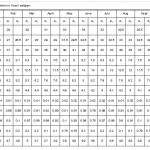 |
Table 1: Different Water quality parameters in Urani saltpan Click here to View table |
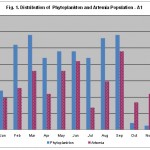 |
Figure 1: Distribution of phytoplankton and artemia population Click here to View figure |
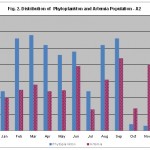 |
Figure 2: Distribution of phytoplankton and artemia population Click here to View figure |
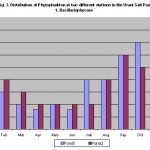 |
Figure 3: Distribution of phytoplankton |
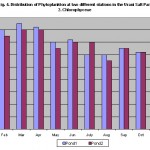 |
Figure 4: Distribution of phytoplankton and artemia in the solar salterns at Tuticorin Click here to View figure |
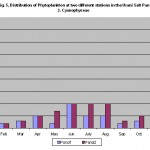 |
Figure 5: Distribution of phytoplankton and artemia in the solar salterns at Tuticorin Click here to View figure |
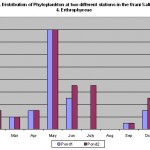 |
Figure 6: Distribution of phytoplankton and artemia in the solar salterns at Tuticorin Click here to View figure |
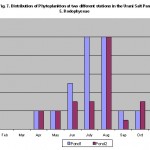 |
Figure 7: Distribution of phytoplankton and artemia in the solar salterns at Tuticorin Click here to View figure |
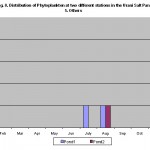 |
Figure 8: Distribution of phytoplankton and artemia in the solar salterns at Tuticorin Click here to View figure |
Phytoplankton and Artemia Distribution
Phytoplankton biomass in the Pond I ranged between (0.13 x 105) Nos / m3 and (2.9 x 105) Nos / m3. In pond II it ranged ranged between (0.12 x 105) Nos / m3 and (2.9 x 105) Nos / m3. The distribution of the phytoplanktons seemed to follow a pattern. In both Pond I and II when the occurrence of species belonging to Bacillariophyceae were more, during premonsoon and monsoon, species of Chlorophyceae were less. The Bacillariophyceae were low in Summer (8%) while in Monsoon they were high (about 40%).
The species of phytoplankton under Cyanophyceae were found to dominate during the monsoon season and it was low during other seasons. The group of Erythrophyceae was found to dominate in the summer season and Rodophyceae was abundant in premonsoon season. The population of artemia was also recorded during these seasons. The population of artemia was found to be high during premonsoon, in both the ponds when the phytoplankton Chlorophyceae was found to dominate.
In Pond I a very high Artemia Population (2.4 x 105) was recorded during premonsoon season, during which phytoplankton Bacillariphyceae species was dominant. The next higher population of artemia (2.1 and 1.8) x 105 Nos / m3 was recorded during summer season when Chlorophyceae and Erthrophyceae was high.
In Pond II a high Artemia population (2.2 x 105, 1.9 x 105) was recorded during monsoon season. The phytoplankton, Bacillariophyceae and Cyanophyceae species were dominant during this season. During the summer season artemia population of 1.4 x 105 Nos / M3 was recorded and Chlorophyceae species were dominant during this season.
Chakraborti et al., (1985) reported that temperature varied from 25.6oC – 29.8oC in the brackish water. Temperature was significant at 1% level in the brackish water (Sathyajith et al., 1993). The temperature in the Veppalodai salt pan (Tuticorin) varied from 24.8oC – 30.7oC. (Bensam et al., 1975). The salinity values ranged from 22.4% - 29.2% in the Veppalodai salterns and the pH value was in the ranges between 7.9 – 8.25. (Marichamy et al., 1987). Dissolved oxygen varied from 3.3 – 4 ppm in Tuticorin Salt pan. (Gopalakrishnan et al., 1994) as also noted in the present study. The phosphate concentration showed an increase in the salt lagoons. Phosphate in the soil phase was more than 1.32 mg.100g.
Magnesium hardness was found to increase with salinity. The maximum concentration recorded in Vedaranyan salt pan was 9679 mg/l and minimum was 1769.5 mg/l. The calcium level was lower than the magnesium concentration in the salt pans (Sundararaj et al., 2006).
Hydrobiological conditions of the solar salt works were influenced by the tidal Oscillations. The higher saline habitats are characterized by large tidal changes in temperature and dissolved oxygen. (Dane, 1981).
Phytoplankton and Zooplankton characteristics of both the Vedaranyam and Kelambakkam salt pans indicated the richness of the plankton community (Mustafa 1995).
Artemia sp is characteristic of hypersaline water and is well adapted to saltpan ecosystem through its ability to Osmoregulation, utilization of oxygen at low level via haemoglobin and tolerance for a broad temperature range, It was observed that pH, nutrients and predominance of selective phytoplankton as food like Dunaliella salina were some of the important factors controlling the distribution of Artemia in a saltpan ecosystem. (Mustafa., 1995).
Sundararaj et al 2006, reported the presence of the phytoplankton community Cyanophyceae, Chlorophyceae, Bacillariophyceae and Dinophyceae in Vedaranyam and Kelambakkam solar salt works. Primary producers in a saltpan ecosystem consists of phytoplankton community such as Cyanophyceae, Chlorophyceae, Bacillariyophyceae and Dinophyceae. A study of phytoplankton population revealed that the density and diversity at Kelambakkam were very poor when compared to Vedaranyam. (Sundararaj, et al., 2006)
Davis (1980) also reported that decrease in Artemia population when the phytoplankton population reached its maximum may be related to the appearance f predators and competitors like amphipods, copepods, larvae and juveniles of crustaceans and molluscs at low salinities and the presence of migratory birds including flamingos. The same condition was also observed in the present study during summer. But during the monsoon the phytoplankton was found to decrease but the artemia population was the highest level
Acknowledgements
The first author is indebted to Department of Science and Technology for the project sanctioned by them during which the work has been carried out.
References
- Bensam, P. and Marichamy, R. 1975. An experiment on culture of milk fish chanos chanos (Forsual) in Saltpans at Veppalodai, Tuticorin. CMFRI : 266 – 269.
- Chakaraborti, R.K., Ravichandran, P., Halder D.D., Mundal, S.K. and Sanfui, D. 1985. Some physico chemical characteristics of Kakdwip brackish water ponds and their influence on the survival growth and production of penaeus monodun (fabricious). J. fish 32(2) : 224 – 235.
- Dana, G.L., (1981), Comparative Population Ecology of the Brine Shrimp Artemia. Thesis San Fransisco State University, California, USA, 125 pp.
- Davis, J.S., (1980), Experience with Artemia at Solar salt works. In : The Brine Shrimp Artemia. Vol. 3 Ecology, Culturing use in aquaculture.
- FAO. Manual of methods in aquatic environment. 137 (1975). pp 238.
- Gobalakrishnan, P., Manikanda Velu, D. and Srinivasan, A, 1994. Ecology of Uppodai Backwater (Tuticorin) for Aquaculture Journal – Ecobiology, 6(1) : 73 – 75.
- Hecky, R.E. and P. Kilham (1973), Diatoms in alkaline lakes ecology and geochemical implications Limnos. Oceanogr., 18 : 53-71.
- James D.B, Marisamy. R & Deivendra Gandhi. A, 1990. Experiments on the Culture of Penacus monodon in the saltpan area at Tuticorin. The second Indian Fisheries Forum proceedings May 27 – 31, 1990. Mangalore. P47 – 49
- Marisamy. R & John Motha. 1986. Prospects of prawn culture in saltpan areas. Mar. Fish. Infor. Serv. T & E Se. No. 70 : 1 – 7.
- Mustafa, S., Ecology of Plankton from saltpans along the Coastal Environment of Bombay, Ph.D. thesis University of Bombay, India, 1995.
- Mustafa, S., Vijayalakshmi R. Nair and K. Govindan (1999). Zooplankton Community of Bhayandar and Thane saltpans around Bombay. Indian Journal of Marine Sciences Vol. 28, June 1999, pp 184 – 191.
- Post, F.J., Borowitzka L.J. Mackay B. and Moulton. T (1983). The Protozoa of a western Australian hypersaline lagoon, hydrobiologies 105 : 95 – 113.
- Robert, E.H. and Peter. K. (1973), Diatoms in alkaline saline lakes : Ecology and geochemical implication. Limnol and Oceangr. 19(1) : 53 – 71.
- Sathyajith, D. and Simpson Manickam, P.E. 1993. Studies on the interstitial salinity and related Environmental Parameters of certain Brackish water prawn culture ecosystem, CMFRI, Spl. Publication, 55 : 115 – 121.
- Sorgeloos, P. Lavens, P., Leger, P., Tackaert, W. and Versichele, D., (1986). Manual for the culture and use of the Brine Shrimp Artemia in Aquaculture. Artemia Reference Centre. State University of Ghent, Belgium.
- Sundararaj, T.D., Ambika Devi, M. C. Shanmugasundaram and Abdul A. Rahman (2006). Dynamics of Soalr saltworks ecosystem in India proceedings of the 1st International Conference on the Ecological Importance of Solar saltworks. (CEISSAo6) 122.
- Wongrat, L., (1986) Biological analysis of Artemia culture from salt cum Artemia farm. National Artemia Reference Centre, NARC/TP/No., 38 pp.






